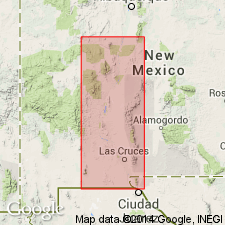
- Usage in publication:
-
- Salinas Peak Member
- Modifications:
-
- Named
- Dominant lithology:
-
- Sandstone
- Shale
- Siltstone
- Limestone
- AAPG geologic province:
-
- Orogrande basin
Summary:
Named the basal member of Contadero Formation for exposures at its type locality on southwest flank of Salinas Peak in NW1/4 NW1/4 SE1/4 sec 7, T12S, R4E, Otero Co, NM in the Orogrande basin. Is recognizable south toward Cottonwood Canyon; cannot be separated from other members of Contadero south of pinchout of the overlying Thurgood Member--formerly designated Thoroughgood Formation, spelling changed and redesignated middle member of Contadero--which is between Cottonwood Canyon (Otero Co) and Hembrillo Canyon (Dona Ana Co). Is 10.8 ft thick at its type, 2.7 m thick at Capital Peak to north, and to south of type 12.5 m thick at Rhodes Canyon and 7.6 m thick at Cottonwood Canyon. Divisible into 1) tan to red shale at base, 2) brown or green silty shale, interbedded thin, coarse siltstone or flaggy, very fine grained sandstone, and 3) nodular, argillaceous, resistant, blue-gray limestone with abundant, large solitary corals. Forms slope-and-step weathering profile. Where Thurgood is missing, Salinas Peak underlies Rhodes Canyon Member (new) of Contadero. Overlies Sly Gap Formation. Conodont and brachiopod faunas determined to be late Frasnian. Assigned a Late Devonian age. Cross section; correlation chart; geologic map.
Source: GNU records (USGS DDS-6; Denver GNULEX).
For more information, please contact Nancy Stamm, Geologic Names Committee Secretary.
Asterisk (*) indicates published by U.S. Geological Survey authors.
"No current usage" (†) implies that a name has been abandoned or has fallen into disuse. Former usage and, if known, replacement name given in parentheses ( ).
Slash (/) indicates name conflicts with nomenclatural guidelines (CSN, 1933; ACSN, 1961, 1970; NACSN, 1983, 2005, 2021). May be explained within brackets ([ ]).

